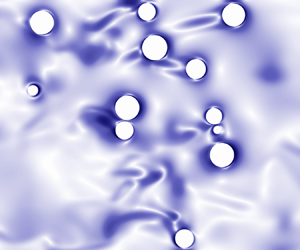Published online by Cambridge University Press: 09 September 2020

Coordinated laboratory experiments and computational simulations are conducted that explore the collective vertical migration of a swarm of inertial swimmers through a stably stratified density interface. Values of the governing parameters such as the swimmer- and swarm-scale Reynolds numbers, the Richardson number, as well as the animal number density in the swarm closely match each other in the simulations and experiments. In addition to intense mixing at the swimmer scale, the experiments and simulations demonstrate that the hydrodynamic interaction of the individual swimmers produces a spatially coherent source of thrust that results in the formation of a swarm-scale jet in the direction opposite to the migration. The jet velocity is seen to increase monotonically with the animal number density, at a sublinear rate. For steadily moving dilute swarms, the jet velocity is well predicted by a simple analytical model that assumes spatially uniform jet and swimmer velocities. Experimental measurements demonstrate effective diffusivity values up to three orders of magnitude larger than the molecular value. Numerical results are consistent with these observations, although they employ a larger molecular diffusivity and, hence, yield a lower ratio. The effective diffusivity is seen to increase linearly with the volume fraction of the swimmers. A continuum model is proposed for the generation of the swarm-scale jet, based on an idealization of the swarm as a self-propelled porous sphere. This model suggests that large swarms generate most of their mixing through the coherent swarm-scale jet, rather than by processes at the scale of individual swimmers.